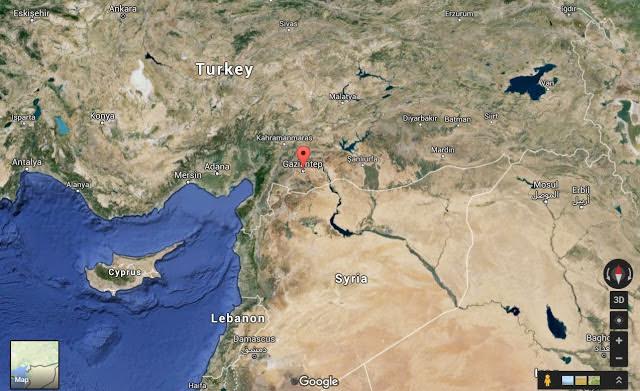Iran and Russia Join the Global Alliance to Preserve Syria’s Endangered Heritage
SYRIA IN CONTEXT, 11 Apr 2016
Franklin Lamb – TRANSCEND Media Service
8 Apr 2016 – The Islamic Republic of Iran announced this week that it is ready to take part in the restoration of archeological monuments damaged or destroyed by ISIS terrorists in Palmyra (Tadmor), which was named one of the six UN World Heritage Sites in Syria in 1980.
The Head of Iran’s Cultural Heritage, Handicrafts and Tourism Organization, Masoud Soltanifar stressed this week his country’s readiness to participate in the process of restoring and rehabilitating the archeological and cultural sites that were demolished by the terrorists in Syria, particularly those in Palmyra.
The Iranian ISNA News Agency quoted Soltanifar as saying in a letter he sent this week to Director-General of the United Nations Educational, Scientific and Cultural Organization (UNESCO) Irina Bokova that Iran is ready to join in conserving and restoring both movable and immovable endangered Syrian cultural heritage archeological sites because they are part of the global heritage of all of us. On March 27, Dr. Maamoun Abdul-Karim, Director General of Antiquities and Museums (DGAM) concurred and described a preliminary vision for a rehabilitation plan to restore the glory of Palmyra.
Perhaps ironically, the Iranians reportedly want to initially restore, among other damaged sites, the 2000 year old Arc de Triomphe which was erected to commemorate the victory of the Romans over Iran’s ancestors after the Roman legions drove or the Persian army.
| Iran’s commitment letter added that “Given the Islamic Republic of Iran’s responsibility with endangered Syrian cultural heritage, [Tehran’s] Cultural Heritage organization stresses its readiness to protect, restore and repair cultural heritage in Syria, especially in Palmyra.” The letter was addressed to UNESCO Director-General Irina Bukova and arrived a day after the head of an Iranian parliamentary delegation visiting Damascus announced that Tehran had “already started developing a program for the reconstruction” of Syria. |
Nearly simultaneously with this much welcomed Iranian initiative, on March 31, 2016 the Russians suddenly pledged to join other nations to preserve our shared global cultural heritage in Syria. Ambassador Vitaly Churkin, Russia’s envoy to the United Nations, sent a letter to the UN Security, asking that it be widely distributed, and pledged that Russia will combat named dealers and shippers who are alleged to be facilitating the trade of looted antiquities from ISIS-controlled territory in Syria.
According to culture heritage lawyer Rick St. Hilaire, the communication caught the attention of cultural property watchers, the media, as well as the government of Turkey because of the strong language Russia’s ambassador used.
Wrote the Russian Ambassador to the UN Security Council: “Around 100,000 cultural objects of global importance, including 4,500 archaeological sites, nine of which are included in the World Heritage List of the United Nations Educational, Scientific and Cultural Organization (UNESCO), are under the control of the Islamic State in Iraq and the Levant (ISIL) in Syria and Iraq. The profit derived by the Islamists from the illicit trade in antiquities and archaeological treasures is estimated at US$ 150-200 million per year.”
As this observer has written more than once recently, there is little material or probative evidence supporting such a dramatically high and unverified Russian estimate of ISIS profits from looting and flogging Syria’s and our cultural heritage. A more realistic number is around two million dollars per month, according to Syrian and UNESCO sources.
However, Mr. Churkin does accurately claim that “individuals in possession of a written permit stamped by this ‘department’ are permitted by the Islamists to carry out excavations and to remove and transport excavated items.” UNESCO and the governments of Syria and the United States have expressed the same opinion.
The Russians imply that their agents have been investigating what looters of Syrians antiquities do with them after excavations and offer specificity:
“It has been observed that new offices for the purchase of antiquities have opened on the Turkish-Syrian border in the administrative district of Akçakale
(640 km south-east of Ankara, Åžanlıurfa Province). Ismet Eren, the owner of an antique shop at 24 Karanfil Street in the town of Kilis, is involved in the illicit trade. Bulky goods are delivered by the Turkish transport companies Åenocak Nakliyat, Devran Nakliyat, Karahan Nakliyat and Egemen Nakliyat. Smuggled artifacts (jewellery, coins, etc.) then arrive in the Turkish cities of Izmir, Mersin and Antalya, where representatives of international criminal groups produce fake documents on the origin (ed: provenance) of the antiquities.”
| The Russians Are Naming Names |
The Russians report that their agents are observing our cultural heritage antiquities being offered to collectors from various countries, generally through Internet auction sites such as eBay and specialized online stores (vauctions.com, ancients.info, vcoins.com, trocadero.com and auctionata.com). The sites osmanlielsanatlari.com, kaynarcopper.com and ertasantik.com are also used to find buyers. To hid their activities, the thieve use IP-address spoofing, which makes it difficult to identify and determine the actual location of the seller.
It is known that ISIS has been increasingly using social media so as to cut out the middleman and sell artifacts directly to buyers. Preference is given to US dollar transactions, while transactions conducted over the Internet involve the same financial institutions as are involved in transactions for the purchase of weapons and ammunition.
Ambassador Churkin also identified new offices that have recently opened for the purchase and sale of antiquities and listed sites on the Turkish-Syrian border in the administrative district of Akçakale. As cultural heritage lawyer |Rick St. Hilaire, notes: “He daringly identified the owner of an antique shop in the town of Kilis as a person “involved in the illicit trade” before proceeding to list individual Turkish transport companies that carried “bulky goods,” describing how “[s]muggled artifacts (jewellery, coins, etc.) then arrive in the Turkish cities of Izmir, Mersin and Antalya, where representatives of international criminal groups produce fake documents on the origin of the antiquities.”
All of us, because we want to preserve and restore our past for the future will applaud these Russian and Iranian initiatives. And the joining of both countries with many other nations, who under the supervision and direction of the Syrian government, and its remarkable Directorate-General of Antiquities & Museums (DGAM), which for the past five years has worked to preserve and protect our cultural heritage which has been in Syrian custody for ten millennia.
_____________________________________
Franklin P. Lamb, LLB, LLM, PhD, Legal Adviser, The Sabra-Shatila Scholarship Program, Shatila Camp (SSSP-lb.com). Volunteer with the Palestine Civil Rights Campaign, Beirut and Washington, DC committed to help achieving the Right To Work and the Right to Home Ownership for every Palestinian Refugee in Lebanon. Lamb’s recent book, Syria’s Endangered Heritage, An international Responsibility to Protect and Preserve, is available on Amazon and other ebook outlets as well as at www.syrian-heritage.com .
For Syria Heritage Updates please visit:
www.Syrian-heritage.com
This article originally appeared on Transcend Media Service (TMS) on 11 Apr 2016.
Anticopyright: Editorials and articles originated on TMS may be freely reprinted, disseminated, translated and used as background material, provided an acknowledgement and link to the source, TMS: Iran and Russia Join the Global Alliance to Preserve Syria’s Endangered Heritage, is included. Thank you.
If you enjoyed this article, please donate to TMS to join the growing list of TMS Supporters.

This work is licensed under a CC BY-NC 4.0 License.

